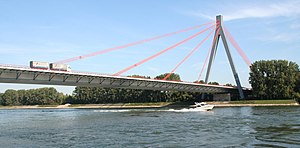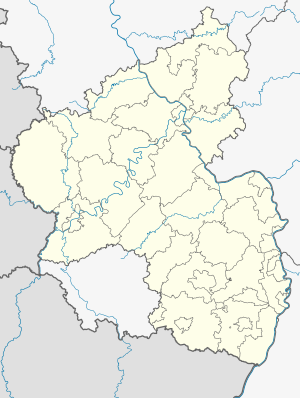Rhine bridge Speyer (A 61)
Coordinates: 49 ° 20 ′ 29 ″ N , 8 ° 28 ′ 22 ″ E
|
|
||
|---|---|---|
| Convicted | Federal motorway 61 | |
| Crossing of | Rhine | |
| place | Speyer , Hockenheim | |
| construction | Cable-stayed bridge | |
| overall length | 456 m + 302 m | |
| width | 33 m | |
| Longest span | 275 m | |
| Construction height | 4.2 m | |
| start of building | 1971 | |
| completion | 1974 | |
| location | ||
|
|
||
The Speyer Rhine Bridge spans the Rhine three kilometers northeast of the center of Speyer . It is located south of the Angelhofer Altrhein area . The overpass with a single-hip cable - stayed bridge in the river area is part of the federal motorway 61 and lies between the Speyer and Hockenheim junctions .
The bridge train is a total of 758 m long and has two lanes and a shoulder lane for each lane. The building was erected between 1971 and 1974. It was opened on December 10, 1974 by Federal Transport Minister Kurt Gscheidle . The main bridge cost 57 million DM.
From 2008 the bridge superstructure was repaired. The work was completed on December 16, 2012.
draft
The structure spans the Rhine and the foreland between the flood dams. No piers were permitted in the current area, and a clear height of 9.1 m at the highest navigable water level had to be maintained. Under these conditions, an asymmetrical single-hip cable-stayed bridge was chosen as the bridge construction in the river area. The pylon was arranged on the right bank of the Rhine in order to influence the silhouette on the left bank of the Rhine with the Speyer Cathedral as little as possible. On the left bank of the Rhine there is also a foreland bridge, which is supported on a separating pillar with the river bridge.
construction
Superstructures
The approach bridge is a 302 m long prestressed concrete structure with a T-beam cross section and eight fields. The spans are uniformly 37.76 m.
The cable-stayed bridge has a steel superstructure, in the transverse direction with a 14.5 m wide two-cell box girder cross-section and a 33 m wide orthotropic deck . The construction height is 4.2 m. Cross beams at a distance of 2.55 m and diagonal struts at a distance of 7.64 m support the 9.25 m cantilevered road construction.
In the longitudinal direction the main bridge has spans of 59 m - 8 × 61 m - 275 m. The current field in the central axis of the bridge is carried by four strands of rope, starting from the pylon, at intervals of 54 m.
The 87 m high steel pylon of the cable-stayed bridge is A-shaped and is completely separate from the stiffening girder. In the central axis of the bridge, four groups of ropes are anchored in the pylons on both sides. These are arranged in a fan shape in the current field, and the anchoring in the eastern abutment takes place in one go. The stems of the pylon have square external dimensions, 2.5 m below and increase in size towards the top.
Substructures and foundation
Between the pylon posts, the superstructure is supported on a 17.5 m wide pillar made of reinforced concrete that is separate from them . Support is also provided by two foreland pillar discs, the dividing pillar on the right bank of the Rhine and the abutment on the right bank of the Rhine , where the superstructure is rigidly fixed. In general, there are shallow foundations in the existing layers of gravel.
See also
literature
- G. Epple, E. Rössing, E. Schaber, L. Wintergerst: The new Rhine bridge for the federal motorway near Speyer. In: Der Stahlbau 46th year 1977, pp. 297–308, 341–353, 372–383.
- BDB district group Speyer: Speyer and its bridges . Speyer 1987, ISBN 3-87928-873-9 .
- Jörg Schlaich, Matthias Schüller: Engineering manager Baden-Württemberg . Bauwerk Verlag, Berlin 1999. ISBN 3-934369-01-4 .
Web links
Individual evidence
- ↑ Hans Schuppel: New asphalt instead of cracks and ruts , Hockenheimer Tageszeitung, Thursday, October 6, 2011
- ↑ Press release of the Karlsruhe Regional Council from December 14, 2012
|
The next bridge upstream: Salier Bridge |
Bridges over the Rhine |
The next bridge downstream: Konrad-Adenauer-Brücke (Mannheim) |



